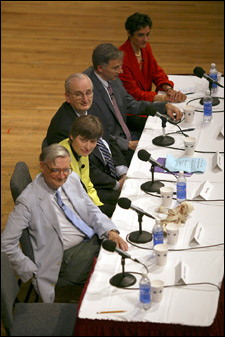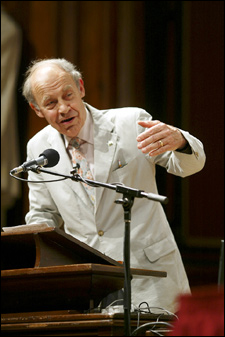Alums get on the cutting edge of science
Learn about stopping light and blocking cancer
It was a science picnic for alums. A 50th reunion symposium on June 9 featured

five of the best minds on the Harvard faculty, if not in the world.
Edward O. Wilson talked about a possible extinction of life on Earth worse than the devastation that eliminated the dinosaurs and other creatures 65 million years ago. Lene Hau described how to stop light, the fastest thing in the universe. Judah Folkman discussed the possibility of killing cancer tumors while they are too small to see. Douglas Melton explained the value of 17 new lines of stem cells created at Harvard. Carla Shatz told people how their brains would be different when they left the symposium.
Dudley Herschbach, a Nobel laureate and Frank B. Baird Jr. Research Professor of Science, introduced the speakers to a full house at Sanders Theatre. First up was Wilson, Pellegrino University Professor Emeritus and winner of two Pulitzer Prizes, who added an honorary degree from Harvard to his laurels the next day. Herschbach noted that Wilson dreamed of running a four-minute mile as a boy, before that mark was actually reached. “E.O. got as far as doing it in five minutes,” Herschbach said, “then he decided to settle back and study something he could outrun – ants.”
“I still haven’t given up the idea of running a four-minute mile,” Wilson, 75, announced. His study of ants and what they taught him about human society led Wilson to become a founding father of the field of sociobiology, which started a bitter controversy about the role of biology in human behavior. With that quarrel largely resolved in his favor, Wilson has gone on to try to stall what he sees is the next great extinction of life.
Wilson fears that animals and plants that remain unknown to us are becoming extinct, depriving us of ever learning about millions of species. “We don’t even know how many different species live on our planet,” he said. “Are there 10 million, or 100 million? My guess is that we’ve identified fewer than 10 percent, and that it would take the next 25 years to find the rest.” He then suggested that Harvard students become involved in helping to put together the world’s largest collection of plants and animals. This could be a major contribution to a database that will contain the identities of as many creatures as is possible to catalog before they go the way of dinosaurs.
Where would Harvard students go to find new species? Melton asked Wilson. “On their shoes for a start,” Wilson answered. “Then they would look in Harvard Yard and in woods in and around Boston.”
Stop light
Normally, light travels about 45 million miles in four minutes, but Lene Hau, Gordon McKay Professor of Applied Physics and professor of physics, slowed it down to 38 miles an hour in 1999. Two years later, she stopped it completely, then restarted the beam and sent it on its way.
She described how she and her colleagues built an “optical molasses” of laser beams that cooled light down to near 460 degrees below zero. When it hits this molasses, a one-mile-long beam of light is compressed into ten-thousandths of an inch. That sort of compression could lead to optical computers and communications lines handling words and numbers at speeds and in volumes only imagined today.
On a more personal level, Herschbach described how Hau once worked in her native Denmark wrapping cheese and meat at a rate of thousands of packages a day.
Then Herschbach noted that Judah Folkman, after failing to be accepted into Harvard as an undergraduate, has changed the world of medicine with the drugs developed in his laboratory at Children’s Hospital in Boston. Now Julia Dyckman Andrus Professor of Pediatric Surgery at Harvard Medical School, Folkman talked about the ups and downs of his drugs. First they were ballyhooed as the magic bullet that would starve all cancer tumors by cutting off their blood supply.
When things didn’t turn out that way, Fortune magazine lambasted the drugs as disappointing and ineffectual. The truth seems to lie somewhere between. One such drug, Avastin, was approved in February for treating patients with advanced colon cancer. About a half dozen others are in trials with human patients for treating other cancers.
The most intriguing possibility Folkman raised involves using these blood vessel-growth inhibitors to prevent cancer. Many people develop small tumors that never grow to threatening size. Down syndrome patients boast high levels of a natural inhibitor called endostatin, first identified in Folkman’s lab. He is investigating the strategy of putting these two facts together to give healthy people continuous small doses of endostatin to kill tumors too small to cut out surgically or to destroy with radiation.
New cells and brains
Herschbach noted that Douglas Melton earned two bachelor’s degrees, one in

biology and one in philosophy, neither from Harvard. The latter has helped Melton, Thomas Dudley Cabot Professor of the Natural Sciences, deal with the attention he is getting from biologists and politicians for developing 17 new lines of stem cells.
“Cells are the unit of life, not genes,” Melton maintained. “Stem cells are capable of developing into all other types of cell as an embryo grows.” It is possible to make new heart, brain, or kidney cells from them, so they might be used to regenerate tissues lost to diseases such as Alzheimer’s and diabetes.
The federal government will not spend tax dollars on developing new lines of stem cells, insisting that the 64 lines already available are adequate and that no more human embryos should be sacrificed to get cells. Melton, who has looked into the available lines, concluded that viability, restrictions, and costs keep these from being widely available or useful. He used excess embryos donated by couples who underwent in vitro fertilization, wherein embryos are created by uniting sperm and eggs in test tubes.
Why 17 lines of stem cells if any one line of can be made into all types of tissue? Carla Shatz asked Melton. “Because we need enough different cell lines to represent the diversity of people in the world,” he answered. “We also want cells that carry genes for diseases like muscular dystrophy so we can look for ways to treat, even cure, such maladies. Think of how much fun it would be to be an undergraduate student and work on such things.”
Melton’s two children, Emma, 16, and Sam, 12, have juvenile diabetes, a disease for which Melton hopes stem cells eventually will provide a cure.
Herschbach then introduced Shatz as someone who “sacrificed a knee for Harvard” as a member of the ski team when she was a Radcliffe student. She graduated from Radcliffe in 1969 and earned a Ph.D. in neurobiology from the Harvard Medical School in 1976. Shatz is now Nathan Marsh Pusey Professor of Neurobiology and chair of the Department of Neurobiology at the Medical School. She said that she hopes stem cells may someday replace the cartilage lost from her knee.
Shatz noted that infants are not born with the same brain wiring as their parents. The fact that children can easily learn any language when they are young but not as easily when they are older is an example of this, she noted. “Learning changes the brain and we want to know exactly how it does so,” Shatz said.
She and her colleagues study how cells in a developing brain connect up so precisely to form, at the back of the brain, images of what the eyes see. “Trillions of connections are needed for normal sight,” Shatz noted. “In every case, brain cells find their way unerringly from the eyes to the visual cortex of the brain. How are they able to do this? How do they know where to go?”
Shatz hopes that someday she will be able to stand in front of alums with answers to such questions. In the meantime, she left the audience with the thought that new connections are made every day as the brain, young or old, learns new things. “I trust,” she said, “that you will enjoy the changes made by this symposium.”




